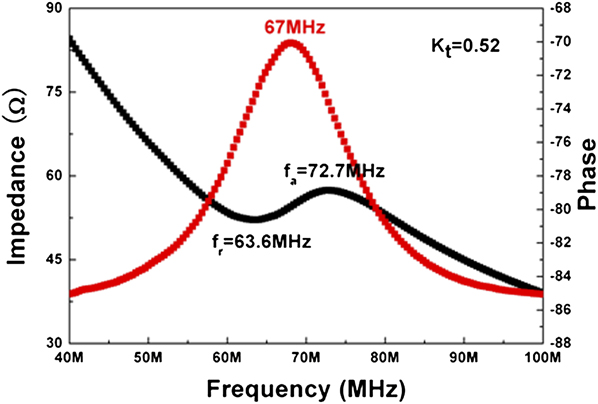Article contents
Self-separated PZT thick films with bulk-like piezoelectric and electromechanical properties
Published online by Cambridge University Press: 01 June 2011
Abstract

Self-separated Pb(Zr0.52Ti0.48)O3 (PZT) films were processed by a hydrothermal deposition and a rapid thermal separation method, followed by a sol–gel filling and sintering process. The films possess excellent piezoelectric and electromechanical properties close to those of bulk material. The maximum remnant polarization is over 30 μC/cm2 and the electromechanical coupling factor (kt) reaches as high as 0.52. The unique microstructure characteristics of the PZT films, such as their highly dense structure, columnar grains, well-connected grain boundaries, and well-dispersed nanopores, could all contribute to the enhanced piezoelectric and electromechanical properties.
Keywords
Information
- Type
- Articles
- Information
- Copyright
- Copyright © Materials Research Society 2011
References
REFERENCES
1.Noheda, B., Gonzalo, J.A., Cross, L.E., Guo, R., Park, S.E., Cox, D.E., and Shirane, G.: Tetragonal-to-monoclinic phase transition in a ferroelectric perovskite: The structure of PbZr0.52Ti0.48O3. Phys. Rev. B 61, 8687 (2000).CrossRefGoogle Scholar
2.Wang, Z.J., Cao, Z.P., Otsuka, Y., Yoshikawa, N., Kokawa, H., and Taniguchi, S.: Low-temperature growth of ferroelectric lead zirconate titanate thin films using the magnetic field of low power 2.45 GHz microwave irradiation. Appl. Phys. Lett. 92, 222905 (2008).CrossRefGoogle Scholar
3.Kang, G.Y., Bae, S.W., Park, H., and Kim, T.S.: Fabrication and electromechanical properties of a self-actuating Pb(Zr0.52Ti0.48)O3 microcantilever using a direct patternable sol-gel method. Appl. Phys. Lett. 88, 042904 (2006).CrossRefGoogle Scholar
4.Foster, E.S., Pavlin, C.J., Lockwood, G.R., Ryan, L.K., Harasiewicz, K.A., Berube, L., and Rauth, A.M.: Principles and applications of ultrasound backscatter microscopy. IEEE Trans. Ultrason. Ferroelectr. Freq. Control 40, 608 (1993).CrossRefGoogle Scholar
5.Polla, D.L. and Francis, L.F.: Ferroelectric thin films in microelectromechanical systems applications. MRS Bull. 21, 59 (1996).CrossRefGoogle Scholar
6.Bernardini, F., Fiorentini, V., and Vanderbilt, D.: Spontaneous polarization and piezoelectric constants of III-V nitrides. Phys. Rev. B 56, 10024 (1997).CrossRefGoogle Scholar
7.Abrar, A., Zhang, D., Su, B., Button, T.W., Kirk, K.J., and Cochran, S.: 1–3 connectivity piezoelectric ceramic–polymer composite transducers made with viscous polymer processing for high frequency ultrasound. Ultrasonics 42, 479 (2004).CrossRefGoogle ScholarPubMed
8.Ishikawa, M., Kurosawa, M.K., Endoh, A., and Takeuchi, S.: Lead zirconate titanate thick-film ultrasonic transducer for 1 to 20 MHz frequency bands fabricated by hydrothermal polycrystal growth. Jpn. J. Appl. Phys. 44, 4342 (2005).CrossRefGoogle Scholar
9.Zhou, Q.F., Shung, K.K., and Huang, Y.: Improvement electrical properties of sol–gel derived lead zirconate titanate thick films for ultrasonic transducer application. J. Mater. Sci. 42, 4480 (2007).CrossRefGoogle Scholar
10.Kanno, I., Fujii, S., Kamada, T., and Takayama, R.: Piezoelectric properties of c-axis oriented Pb(Zr, Ti)O3 thin films. Appl. Phys. Lett. 70, 1378 (1997).CrossRefGoogle Scholar
11.Horwitz, J.S., Grabowski, K.S., Chrisey, D.B., and Leuchtner, R.E.: In situ deposition of epitaxial PbZr xTi 1-xO 3 thin films by pulsed laser deposition. Appl. Phys. Lett. 59, 1565 (1991).CrossRefGoogle Scholar
12.Zhu, B.P., Zhou, Q.F., Shi, J., Shung, K.K., Irisawa, S., and Takeuchi, S.: Self-separated hydrothermal lead zirconate titanate thick films for high frequency transducer applications. Appl. Phys. Lett. 94, 102901 (2009).CrossRefGoogle ScholarPubMed
13.Cho, J., Anderson, M., Richards, R., Bahr, D., and Richards, C.: Optimization of electromechanical coupling for a thin-film PZT membrane: I. Modeling. J. Micromech. Microeng. 15, 1797 (2005).CrossRefGoogle Scholar
14.Cho, J., Anderson, M., Richards, R., Bahr, D., and Richards, C.: Optimization of electromechanical coupling for a thin-film PZT membrane: II. Experiment. J. Micromech. Microeng. 15, 1804 (2005).CrossRefGoogle Scholar
15.Granzow, T., Dorfler, U., Woike, T., Wohlecke, M., Pankrath, R., Imlau, M., and Kleemann, W.: Influence of pinning effects on the ferroelectric hysteresis in cerium-doped Sr0.61Ba0.39Nb2O6. Phys. Rev. B 63, 174101 (2001).CrossRefGoogle Scholar
- 13
- Cited by

